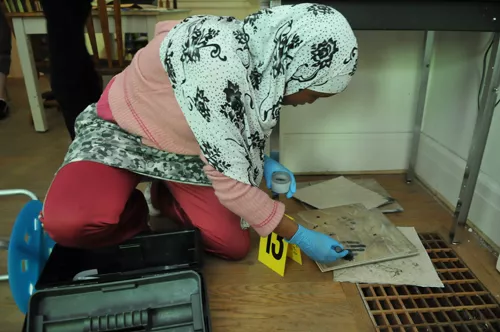
Whodunnit?
Evidence collector Talha Kahloan, 11, stares at the area rug as the investigative team pulls it from under the car. There’s a stain in the middle of the geometric earth-toned design.
“Oh, blood,” Kahloan says. “Is that blood? That is blood. Got it.”
The rug is now evidence in the crime being investigated by forty students from Peel Region’s David Leeder Middle School. Organized by U of T Mississauga’s Forensic Science Program, the students from grades six, seven and eight spent two days on campus learning about forensic science and participating in a mock crime scene investigation.
Kahloan chose the forensic science activity because of his interest in science and mysteries. Like his favourite crime character Sherlock Holmes, deductive reasoning caused him to suspect something under the car, which he noted had the bumper pulled off and tucked in on the side.
The students were split into four teams, each taking turns to investigate different areas of the crime scene at UTM’s Forensic Crime Scene House. Inside the house, chairs are knocked over, items are missing and clues litter the floor.
Sahra Omar, 14, surveys her options before dusting a table with a small wand dipped into magnetic powder. The powder sticks as it goes over the oils left from an individual’s fingers. Or it should. Omar has not yet found any prints.
“It’s fun,” she says. “Criminal Minds is my favourite show.” There are no prints on the table and Omar turns to a grey toolbox on the floor. In moments, her dark powder shows something. “Finally!” she says. “A fingerprint.”
UTM lab technician Agata Gapinska stands to the side, offering guidance as the students work. To set up a realistic crime scene, Gapinska says the UTM team decided on a crime, and then ran through the scenario to decide what the subject touched in order to leave evidence.
“I love seeing the application of what happens in the real world,” she says. “The students have great questions, too.”
Outside the house, two teams have located burial sites. Students set up a 3 x 4 x 5 metre grid with neon twine as Seren Emiroglu, 12, prepares numbered cards.
“I have a passion for science, and forensic science is cool because it’s not something we do in school,” she says. “We keep switching roles so we can experience everything that happens in a crime scene. I definitely liked fingerprint development – it’s very unusual.”
Mark Chen, 12, is getting ready to help with the exhibits, collecting the evidence other teams members find. He chose the forensic Discovery Day because of a Case File book he read. “So far, I liked going into the house and finding the blood, the prints and the knife,” he says.
Kristine Holloway, a grade six teacher at David Leeder, has been organizing the school’s forensic activity since 2008 with her colleague Catharine Rayner. She says the mystery aspect is what attracts many students. “They really like looking for clues and trying to figure out if it is a clue, or not a clue and just part of the house. Is it evidence or not?”
It’s also very hands-on, she says, and gives the students an opportunity to learn about a field and explore career possibilities about which they might not have previous knowledge.
Along with the crime scene investigation, the students will learn about bone identification, fingerprint processing and 3D facial reconstruction, says Tracy Rogers, director of UTM’s Forensic Science Program.
Rogers says that the students have ideas about forensic science from television, and she is careful to discuss those. “They know the shows are not really realistic, but they weren’t sure which parts are and which parts aren’t,” she says.
Monisha Date, 11, shakes dirt from the burial through a screen, looking for evidence. Of all the roles, she most enjoyed being the excavator and uncovering the burial. “It was really fun because if you find something you are the first one to find it,” she says.
As for the crime? As the students discovered, in the end it was the burglar in the living room (and garden) with the steak knife.
Photography by Stephen Uhraney
